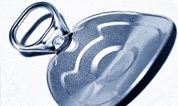Referencias científicas
STATE OF THE ART ASSESSMENT OF ENDOCRINE DISRUPTERS. Final Report. Project Contract Number 070307/2009/550687/SER/D3. Authors: Andreas Kortenkamp, Olwenn Martin, Michael Faust, Richard Evans, Rebecca McKinlay, Frances Orton and Erika Rosivatz. 23.12.2011
http://ec.europa.eu/environment/endocrine/documents/4_SOTA%20EDC%20Final…- A modo de ejemplo, una fuente donde consultar los estudios, tal solo hasta 2005: Endocrine Disruptors Group 2005. Bisphenol A References. Columbia, MO:Curators of the University of Missouri. Available: http://endocrinedisruptors.missouri.edu/vomsaal/vomsaal.html
- Takai et al (2000). Estrogen receptor-mediated effects of a xenoestrogen , bisphenol-A, on preimplantation mouse embyos. Biochem Biophys Res Commun; 270 (3): 918-921. Takai et al (2001). Preimplantation exposure to bisphenol A advances postnatal development. Reprod Toxicol ; 15 (1): 71-74
- Markey CM et al. (2001) In utero exposure to bisphenol A alters the development and tissue organization of the mouse mammary gland. Biol reprod; 65 : 1215-1223
Honma, S.; Suzuki, A.; Buchanan, D.L.; Katsu, Y.; Watanabe, H.; Iguchi, T. (2002): Low dose effect of in utero exposure to bisphenol A and diethylstilbestrol on female mouse reproduction. Revista Reprod Toxicol; 16 (2): 117-22.
Howdeshell, K.L.; Hotchkiss, A.K.; Thayer, K.A.; Vandenbergh, J.G.; vom Saal, F.S. (1999): Exposure to bisphenol A advances puberty. Revista Nature; 401 (6755): 763-4.Gupta, C. (2000): Reproductive malformation of the male offspring following maternal exposure to estrogenic chemicals. Revista Proc Soc Exp Biol Med; 224 (2): 61-8.
Ramos, J.G.; Varayoud, J.; Kass, L.; Rodríguez, H., Costabel, L., Munoz-deToro, M.; Luque, E.H. (2003): Bisphenol A induces both transient and permanent histofunctional alterations of the hypothalamicpituitary-gonadal axis in prenatally exposed male rats. Revista Endocrinology; 144 (7): 3206-15.
Ramos, J.G.; Varayoud, J.; Sonnenschein, C.; Soto, A.M.; Munoz de Toro, M.; Luque, E.H. (2001): Prenatal exposure to low doses of bisphenol A alters the periductal stroma and glandular cell function in the rat ventral prostate. Revista Biol Reprod; 65 (4): 1271-7.Sakaue, M.; Ohsako, S.; Ishimura, R.; Kurosawa, S.; Kurohmaru, M.; Hayashi, Y.; Aoki, Y.; Yonemoto, J.; Tohyama, C. (2001): Bisphenol-A affects spermatogenesis in the adult rat even at a low dose. Publicación J Occup Health; 43: 185-90.
Vom Saal, F.S.; Cooke, P.S.; Buchanan, D.L.; Palanza, P.; Thayer, K.A.; Ángel, S.C.; Parmigiani, S.; Welshons, W.V. (1998): A physiologically based approach to the study of bisphenol A and other estrogenic chemicals on the size of reproductive organs, daily sperm production, and behavior. Toxicol Ind Health; 14(1-2):239-60
Nagel, S.C.; vom Saal, F.S.; Thayer, K.A.; Dhar, M.G.; Boechler, M.,Welshons, W.V. (1997): Relative binding affinityserum modified access (RBA-SMA) assay predicts the relative in vivo bioactivity of the xenoestrogens bisphenol A and octylphenol. 62 Revista Environ Health Perspect; 105 (1): 70-6.
Nagel, S.C.; vom Saal, F,S,; Welshons, W.V. (1999): Developmental effects of estrogenic chemicals are predicted by an in vitro assay incorporating modification of cell uptake by serum. Publicación J Steroid Biochem MolBiol; 69 (1- 6): 343-57.- Adriani, W.; Seta, D.D.; DessiFulgheri, F.; Farabollini, F.; Laviola, G. (2003): Altered profiles of spontaneous novelty seeking, impulsive behavior, and response to Damphetamine in rats perinatally exposed to bisphenol A. Revista Environ Health Perspect; 111 (4): 395-401.
- Kawai, K.; Nozaki, T.; Nishikata, H.; Aou, S.; Takii, M., Kubo, C. (2003): Aggressive behavior and serum testosterone concentration during the maturation process of male mice: The effects of fetal exposure to bisphenol A. Revista Environ Health Perspect; 111 (2): 175-8.
- Frederick S. vom Saal and Claude Hughes. An Extensive New Literature Concerning Low-Dose Effects of Bisphenol A Shows the Need for a New Risk Assessment Environ Health Perspect. 2005 August; 113(8): 926–933.
- Palanza, P.L.; Howdeshell, K.L.; Parmigiani, S.; vom Saal, F.S. (2002): Exposure to a low dose of bisphenol A during fetal life or in adulthood alters maternal behavior in mice. Revista Environ Health Perspect; 110 (Supl. 3): 415-22.
- Alonso-Magdalena P, Morimoto, S, Ripoll, C, Fuentes, E, Nadal, A. 2006. The estrogenic effect of bisphenol A disrupts pancreatic beta-cell function in vivo and induces insulin resistance. Environmental health perspectives 114(1): 106-112.
Lang Al et al (2008) Associattion of urinary bisphenol A concentration with medical disorders and laboratory abnormalities in adults. Journ Am Med Assoc 300 (11) 1303-1310
Vom Saal FS and Myers JP (2008) Bisphenol A and risk of metabolic disorders. JAMA 300 (11): 1353-1355
Melzer D., Rice N.E., Lewis C., Henley W.E., Galloway T.S. (2010). Association of Urinary
Bisphenol A Concentration with Heart Disease: Evidence from NHANES 2003/06. PLoS ONE 5 (1 e8673): 1-9.- Ikezuki Y et al (2002) Determinatios of bisphenol A concentrations in human biological fluids reveals significant early prenatal exposure. Human Reprod; 17: 2839-2841
E. Kandaraki. A.Chatzigeorgiou, S. Livadas, E. Palioura, F. Economou, M. Koutsilieris, S. Palimeri, D. Panidis, E. Diamanti-Kandarakis. Endocrine Disruptors and Polycystic Ovary Syndrome (PCOS): Elevated Serum Levels of Bisphenol A in Women with PCOS. Journal of Clinical Endocrinology & Metabolism,2010.
Takeuchi T y Tsutsumi O (2002). Serum bisphenol A concentrations showed gender differences, possibly linked to androgen levels. Biochem Biophys Res Commun; 291 (1): 76-78
Takeuchi T, Tsutsumi O, Ikezuki Y, Takai Y, Taketani Y. Positive relationship between androgen and the endocrine disruptor, bisphenol A, in normal women and women with ovarian dysfunction. Endocr J. 2004;51:165–169.- Takeuchi T, Tsutsumi, O., Ikezuki, Y., Kamei, Y., Osuga, Y., Fujiwara, T., Takai, Y., Momoeda, M., Yano, T., Taketani, Y. 2006. Elevated serum bisphenol A levels under hyperandrogenic conditions may be caused by decreased UDPglucuronosyltransferase activity. Endocrology journal 53(4): 485-491.
- Cobellis L., Colacurci N., Trabucco E., Carpentiero C., Grumetto L. (2009). Measurement of bisphenol A and bisphenol B levels in human blood sera from healthy and endometriotic women. Biomedical Chromatography 23 (11): 1186-1190.
- Hunt PA, Koehler, KE, Susiarjo, M, Hodges, CA, Ilagan, A, Voigt, RC, Thomas, S, Thomas, BF, Hassold, TJ. 2003. Bisphenol A exposure causes meiotic aneuploidy in the female mouse. Current biology 13(7): 546-553.
Sugiura-Ogasawara, M, Y Ozaki, S Sonta, T Makino and Kaoru Suzumori 2005. Exposure to bisphenol A is associated with recurrent miscarriage. Human Reproduction 20:2325-2329.
Yamada et al (2002). Maternal serum and amniotic fluid bisphenol A concentrations in the early second trimester. Reprod Toxicol; 16 (6): 735-739
Rubin, B. S.; Soto, A. M. (May 2009). Bisphenol A: Perinatal exposure and body weight. Molecular and cellular endocrinology 304 (1–2): 55–62
Elobeid, M. A.; Allison, D. B. (October 2008). Putative environmental-endocrine disruptors and obesity: a review. Current Opinion in Endocrinology, Diabetes and Obesity 15 (5): 403–408.
Heindel, J.; Vom Saal, F. (May 2009). “Role of nutrition and environmental endocrine disrupting chemicals during the perinatal period on the aetiology of obesity”. Molecular and cellular endocrinology 304 (1–2): 90–96.
Newbold, P. B. E.; Padilla-Banks, E.; Jefferson, W. N. (May 2009). “Environmental estrogens and obesity”. Molecular and cellular endocrinology 304 (1–2): 84–89.
Grün, F.; Blumberg, B. (May 2009). “Endocrine disrupters as obesogens”. Molecular and cellular endocrinology 304 (1–2): 19–29- Trasande L, Attina TM, Blustein J. Association Between Urinary Bisphenol A Concentration and Obesity Prevalence in Children and Adolescents. JAMA. 2012;308(11):1113-1121. doi:10.1001/2012.jama.11461.
Somm e, S. V.; Schwitzgebel, V. R.; Toulotte, A.; Cederroth, C.; Combescure, C.; Nef, S.; Aubert, M.; Hüppi, P. (October 2009). “Perinatal exposure to bisphenol a alters early adipogenesis in the rat”. Environ. Health Perspect. 117 (10): 1549–1555.
Ryan Kk, H. A.; Haller, A. M.; Sorrell, J. E.; Woods, S. C.; Jandacek, R. J.; Seeley, R. J. (June 2010). “Perinatal exposure to bisphenol-a and the development of metabolic syndrome in CD-1 mice”. Endocrinology 151 (6): 2603–2612.Leranth C, Hajszan T, Szigeti-Buck K, Bober J, Maclusky NJ. Bisphenol A prevents the synaptogenic response to estradiol in hippocampus and prefrontal cortex of ovariectomized nonhuman primates. Proc. Natl. Acad. Sci. U.S.A.. 2008;105(37):14187–91.
Palanza p, G. L.; Gioiosa, L.; Vom Saal, F. S.; Parmigiani, S. (October 2008). “Effects of developmental exposure to bisphenol A on brain and behavior in mice”. Environ. Res. 108 (2): 150–157.
Gore AC (June 2008). “Developmental programming and endocrine disruptor effects on reproductive neuroendocrine systems”. Front Neuroendocrinol 29 (3): 358–74.
Ogiue-Ikeda m, T. N.; Tanabe, N.; Mukai, H.; Hojo, Y.; Murakami, G.; Tsurugizawa, T.; Takata, N.; Kimoto, T. et al. (2008). “Rapid modulation of synaptic plasticity by estrogens as well as endocrine disrupters in hippocampal neurons”. Brain Research Reviews 57 (2): 363–375.
Patisaul, H. B.; Polston, E. K. (2008). “Influence of endocrine active compounds on the developing rodent brain”. Brain Research Reviews 57 (2): 352–362- Braun J.M., Yolton K., Dietrich K.N., Hornung R., Ye X., Calafat A.M., Lanphear B.P. (2009). Prenatal Bisphenol A Exposure and Early Childhood Behavior. Environmental Health Perspectives: 1-34
- Hanaoka T, Kawamura, N., Hara, K., Tsugane, S. 2002. Urinary bisphenol A and plasma hormone concentrations in male workers exposed to bisphenol A diglycidyl ether and mixed organic solvents. Occupational and environmental medicine 59(9): 625-628.
- Li D., Zhou Z., Qing D., He Y., Wu T., Miao M., Wang J., Weng X., Ferber J.R., Herrinton L.J., Zhu Q., Gao E., Checkoway H., Yuan W. (2009). Occupational exposure to bisphenol A (BPA) and the risk of Self-Reported Male Sexual Dysfunction. Hum Reprod: dep381.
- Chemical in Plastic, BPA, Exposure May Be Associated With Wheezing in Children. Science Daily. http://www.sciencedaily.com/releases/2011/05/110501183817.htm
- Myers JP. 2006. Good genes gone bad. American Prospect, April 8, 2006.
- Reprod Toxicol. 2007 Aug-Sep;24(2):131-8. Epub 2007 Jul 27. Chapel Hill bisphenol A expert panel consensus statement: integration of mechanisms, effects in animals and potential to impact human health at current levels of exposure. Vom Saal FS, Akingbemi BT, Belcher SM, Birnbaum LS, Crain DA, Eriksen M, Farabollini F, Guillette LJ Jr, Hauser R, Heindel JJ, Ho SM, Hunt PA, Iguchi T, Jobling S, Kanno J, Keri RA, Knudsen KE, Laufer H, LeBlanc GA, Marcus M, McLachlan JA, Myers JP, Nadal A, Newbold RR, Olea N, Prins GS, Richter CA, Rubin BS, Sonnenschein C, Soto AM, Talsness CE, Vandenbergh JG, Vandenberg LN, Walser-Kuntz DR, Watson CS, Welshons WV, Wetherill Y, Zoeller RT.
- Y estimaban que ésos niveles medios detectados en las personas podían explicarse solo asumiendo que las exposiciones debían estar por encima de los niveles que la Agencia de Protección Ambiental (EPA) consideraba seguros (la dosis de referencia).
- Ho, S-M, W-Y Tang, J Belmonte de Frausto, and GS Prins. 2006.Developmental Exposure to Estradiol and Bisphenol A Increases Susceptibility to Prostate Carcinogenesis and Epigenetically Regulates Phosphodiesterase Type 4 Variant 4. Cancer Research 66: 5624-5632.
Murray, TJ, MV. Maffini, AA Ucci, C Sonnenscheinand AM. Soto. 2006. Induction of mammary gland ductal hyperplasias and carcinoma in situ following fetal bisphenol A exposure. Reproductive Toxicology 23: 383-390.
Vandenberg, LN, MV Maffini, PR Wadia, C Sonnenschein, BS Rubin and AM Soto. 2007. Exposure to environmentally relevant doses of the xenoestrogen bisphenol-A alters development of the fetal mouse mammary gland. Endocrinology 148(1):116-27.- Vom Saal FS, Hughes C. An extensive new literature concerning low-dose effects of bisphenol A shows the need for a new risk assessment. Environ Health Perspect. 2005;113:926–933.
- The impacts of endocrine disrupters on wildlife, people and their environments. The Weybridge+15 (1996–2011) report. EEA Technical report. No 2/2012 . European Environment Agency
- De este particular nos ocupamos en un apartado del anexo final de este informe.
3 Sep 2008: NTP Finalizes Report on Bisphenol A. NIEHS web: http://www.niehs.nih.gov/news/newsroom/releases/2008/september03/
NTP-CERHR Monograph on the Potential Human Reproductive and Developmental Effects of Bisphenol A. September 2008 NIH Publication No. 08–5994. Center for The Evaluation of Risks tTo Human Reproduction (CERHR)- National Toxicology Program (NTP)
http://ntp.niehs.nih.gov/ntp/ohat/bisphenol/bisphenol.pdf- Bisphenol A (BPA): Use in Food Contact Application. Update on Bisphenol A (BPA) for Use in Food Contact Applications. January 2010; Updated March 30, 2012 http://www.fda.gov/newsevents/publichealthfocus/ucm064437.htm
Joint FAO/WHO Expert Meeting to Review Toxicological and Health Aspects of Bisphenol A
Summary Report including Report of Stakeholder Meeting on Bisphenol A. 1–5 November 2010, Ottawa, Canada




